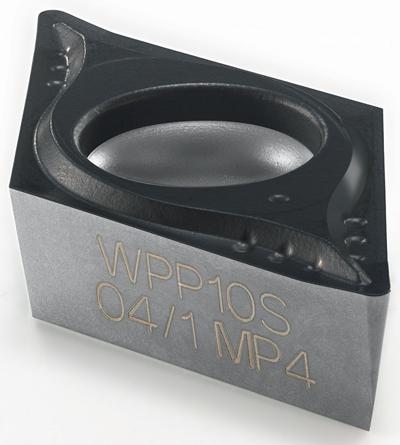
Walter has expanded its Tiger-tec Silver range of indexable inserts with three new ISO P geometries, all possessing a positive cutting edge design. These three new products, the FP4, MP4 and RP4, are available with proven WPP10S, WPP20S and WPP30S Tiger-tec Silver cutting grades. The combination of Tiger-tec Silver and the new geometries can result in significant increases in performance. For example, during a recent auto industry field test an MP4 insert made from WPP10S Tiger-tec Silver produced 60 components in comparison to 35 produced with a competing product.
The new inserts are aimed at specific applications ranges. The FP4 (F = finishing) is optimized for finishing and achieves the best surface finish quality and chip control for precision machining. The MP4 (M = medium) for mid-range machining with a wide feed rate range with good chip control. It is the most universal design of the three new inserts and is particularly well suited to machining materials such as structural steel or other low-carbon steels. Both the MP4 and FP4 geometries have been optimized for short chip breaking, which is effective on long-chipping materials such as structural steels. The MP4 geometry is available with two clearance angles: 7 and 11 degrees. The clearance angle of 11 degree enables machining of smaller diameters with lower tool pressure especially for thin wall or delicate components. Finally, the RP4 (R = roughing) offers a highly stable cutting edge for roughing forged steel parts or cast iron. This insert is an ideal choice for high volume machining.
The positive cutting edge design can offer numerous benefits, such as lower cutting pressures and a lower force cutting action for machining smaller diameters or very long, unstable components. Where these attributes are desirable, a positive cutting edge makes good economic sense. On multispindle machines, for example, users can achieve higher feed rates thanks to the reduced cutting pressure and at the same time benefit from excellent chip control. With Walter's new FP4, MP4 and RP4, information such as the cutting tool material, radius and geometry which previously could only be found on the indexable insert packaging, is now also laser engraved on the side of each individual insert. This helps minimize the risk of machine operators mixing up the inserts.
Contact Details
Related Glossary Terms
- clearance
clearance
Space provided behind a tool’s land or relief to prevent rubbing and subsequent premature deterioration of the tool. See land; relief.
- feed
feed
Rate of change of position of the tool as a whole, relative to the workpiece while cutting.
- indexable insert
indexable insert
Replaceable tool that clamps into a tool body, drill, mill or other cutter body designed to accommodate inserts. Most inserts are made of cemented carbide. Often they are coated with a hard material. Other insert materials are ceramic, cermet, polycrystalline cubic boron nitride and polycrystalline diamond. The insert is used until dull, then indexed, or turned, to expose a fresh cutting edge. When the entire insert is dull, it is usually discarded. Some inserts can be resharpened.
- low-carbon steels
low-carbon steels
Group of carbon steels designated by American Iron and Steel Institute numerical classification as AISI 1005, 1006, 1008, etc., up to AISI 1026, for a total of 16 grades. They are softer and more ductile than other carbon steels. Composition of low-carbon steels is 0.06 to 0.28 percent carbon, 0.25 to 1.00 percent manganese, 0.040 percent (maximum) phosphorus and 0.050 percent (maximum) sulfur. See high-carbon steels; medium-carbon steels.
- precision machining ( precision measurement)
precision machining ( precision measurement)
Machining and measuring to exacting standards. Four basic considerations are: dimensions, or geometrical characteristics such as lengths, angles and diameters of which the sizes are numerically specified; limits, or the maximum and minimum sizes permissible for a specified dimension; tolerances, or the total permissible variations in size; and allowances, or the prescribed differences in dimensions between mating parts.

